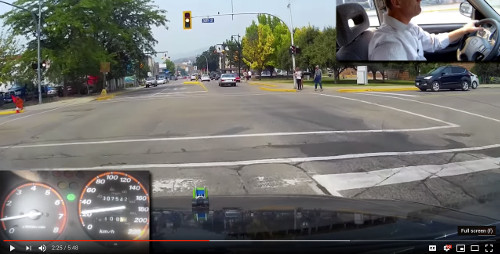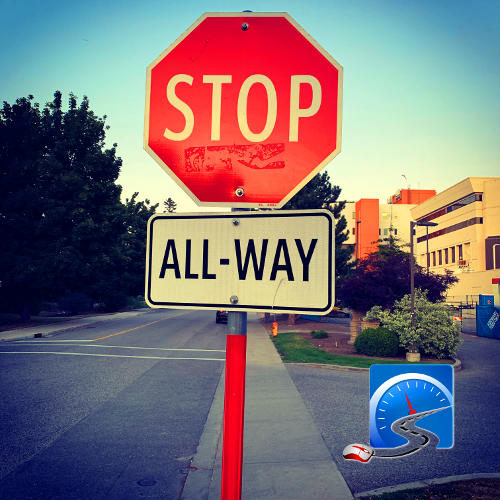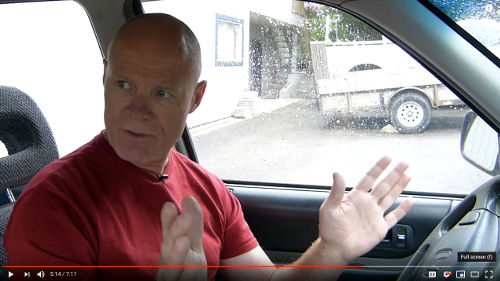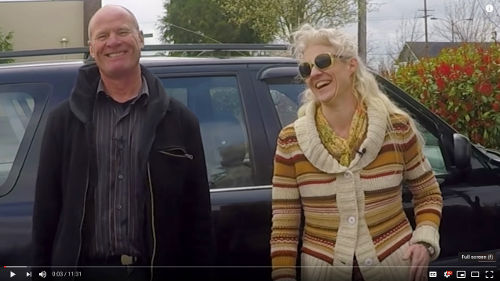No where in any driving manual are these driving test secrets.
The Secrets to Pass Your Driver's Test First Time
Closed Caption
CHAPTERS
00:00 - The Secrets to Pass Your Driver’s Test First Time
00:16 - Passing Your Learner’s Permit
01:06 - Components of a Driver’s Test
03:20 - Learn to Drive Faster With These Exercises
04:12 - Requirements of a Driver’s Test
05:04 - Some of the Things You Need to Do to Pass Your Driver’s Test
06:05 - Lessons With a Driving Instructor
08:14 - The Reality of Taking a Driver’s Test
10:06 - Be Prepared for Test Day
10:43 - You Can Wear Sunglasses
11:54 - How Fast Can You Go When Passing Other Cars
13:31 - You’re Going for the Pass…Not Perfection
14:12 - How Do You Know if You Stopped Behind the STOP Line
15:20 - Yellow & Red Mean the Same on a Driver’s Test
16:14 - Shoulder Check, Shoulder Check & More Shoulder Checks
16:50 - Changing Lanes in Heavy Traffic
18:41 - First Five Minutes of the Driver’s Test are Critical
21:10 - Alberta Removes the Advanced Road Trip
22:25 - What are the Parking Lights?
23:37 - Driving is a Social Activity
24:08 - 2 Schools of Thought for Left Turns
25:23 - You Can’t Do What Other Driver’s Are Doing to Pass Your Test
26:33 - How to Deal With 2-Way STOP Signed Intersections
27:58 - Being Too Cautious Will Cause You To Fail Your Test
29:25 - Where to Look When Backing
30:08 - You Can Turn Right on Red Lights At An Intersection
30:41 - The Way Traffic Communicates
31:19 - Unexpected Events That You Might Have to Deal With On Driver’s Test
32:39 - Some Times You’ll Have to Fake it
33:48 - Some Driver’s Test Are Still Done on a Closed Course
34:42 - The 4 Most Powerful Words in the English Language
35:11 - Most Driving Examiners Are Doing An Awesome Job
35:49 - Focus on What You’re Doing - Keep Going Until Told Otherwise
38:09 - Take Away the Driving Examiner’s Right to Fail You
38:55 - The “What Happens If We Fail Game”
39:45 - Who Has the Right-of-Way?
40:34 - 4-Way STOP Signed Intersection Right-Of-Way Rules
42:41 - The Fallout from Hurricane Fiona
43:10 - Be Sure To Celebrate Passing Your Driver’s Test…It Only Happens Once
Introduction
Most of this secret information can't be found anywhere in any Driver's Handbook. The skills, strategies, and information you need to pass your driver's test first time.
The Driver's Handbook doesn't even come close to giving you the information you need to pass your on-road driver's test.
Here we reveal all the skills, techniques and abilities you need to pass your driver's test...FIRST time.
 A young woman gets the correct information, practices, and passes her driver's test first time.
A young woman gets the correct information, practices, and passes her driver's test first time.
How to make left turns correctly, to changing lanes, to knowing the differences between different STOP signed intersections.
Yes...there's more than one STOP sign.
Space & speed management, communication and observation are the tools that you must have in place to pass your driver's test.
Why Do You Have to Move Right?
After Completing the Left Turn on a Multi-Lane Road you must move back to the right lane.
And no, the driving examiner will not tell you to move back to the right.
However, if you don't move back to the right, the examiner will deduct points for not driving in the right lane.
Every state and province in North America has a regulatory sign: "Slower Traffic Keep Right."
 Most driver's take this sign as a suggestion. When in fact, it's the law.
Most driver's take this sign as a suggestion. When in fact, it's the law.
On a driver's test, you are going to be driving the speed limit.
All other drivers are going to be keeping up with the traffic flow, which is usually 5 - 8 mph faster than the posted speed limit.
This sign is not a suggestion, and it's the reason you should be driving in the right lane for the bulk of your driver's test.
Because you are the slowest driver, you must keep right according to the above regulatory sign.
And no, the examiner will NOT tell you to move back to the right.
Only stay in the left lane if the driving examiner tells you to turn left again in another couple of blocks.
Yellow & Red Mean the Same on a Driver’s Test
Remember a yellow and red light are the same colour for the purposes of a road test.
Now lots of students are somewhat confounded by this: when do you STOP; when do you GO?
And of course, it's a bit experiential.
 For a driver's test, yellow and red mean the same thing - stop if you can do so safely.In other words, you got to go out and actually drive and be confronted by a few yellow lights before you actually sort of figure this out.
For a driver's test, yellow and red mean the same thing - stop if you can do so safely.In other words, you got to go out and actually drive and be confronted by a few yellow lights before you actually sort of figure this out.
No Vehicle Will Stop In Its Own Length
Now one of the other pieces of information that I will give you about yellow lights is that no vehicle—regardless of size, whether it's a truck, a trailer, a bicycle, whatever—will NOT stop in its own length.
Before stopping for a yellow light, ensure that the vehicle behind you isn't so close that you'll risk being rear-ended.
Therefore, a car, most cars are between 15 and 20' feet (3-7M); therefore that vehicle - if you are that distance from the intersection...if you are approximately 20 feet from the intersection, your vehicle is not going to stop.
So, therefore you have to proceed through the intersection on the yellow light.
And of course, stopping abruptly at a yellow light depends on who's following you.
As you're approaching the intersection, take note of the vehicle behind - if any.
If the vehicle is too close, you may have to proceed to prevent being rear-ended.
 On a driver's test, red and yellow lights mean the same. If you can do so safely, stop for yellow lights.
On a driver's test, red and yellow lights mean the same. If you can do so safely, stop for yellow lights.
4-Way STOP Sign: Right-Of-Way Rules
Know the difference between 2-Way & 4-Way STOPs.
At 4-WAY STOPS, it's the first person to arrive.
One lane goes, and then the cross-traffic goes.
Straight through traffic has the right-of-way over turning traffic.
And right turning traffic has the right-of-way over left turning traffic.
If you're not sure, pause and the other person will go.
 Know the difference between 2-WAY & 4-WAY STOP signs for your driver's test.Trust me...they'll go.
Know the difference between 2-WAY & 4-WAY STOP signs for your driver's test.Trust me...they'll go.
Everyone's in a hurry and they don't have time for somebody that's being namby pampy at the 4-WAY STOP.
And if you're arriving at the same time as another vehicle, simply slow and let the other person proceed first.
If you're unsure who goes first, simply pause and the other vehicle will go.
At 2-Way STOPs, know that you have to stop completely at the correct stopping position.
After stopping at the correct place, move forward and treat the intersection as a yield.
In other words, the traffic on the cross street will NOT stop and you have to find a gap before proceeding at the intersection.
Shoulder Check, Shoulder Check & More Shoulder Checks
When you're sitting square in the driver's seat and you're driving - when you do a shoulder check, you have to do two shoulder checks for every turn.
One approximately half a block from the turn and then one immediately before the turn.
And you simply turn your head 90° degrees.
So if I'm shoulder checking to the left, the driver side of the vehicle, simply turn my head 90° degrees.
 NOT shoulder checking is the most common error on a driver's test. You must shoulder (head) check every time you change directions of the vehicle.If I'm checking to the right, to the passenger side of the vehicle, I simply turn my head 90° degrees and look.
NOT shoulder checking is the most common error on a driver's test. You must shoulder (head) check every time you change directions of the vehicle.If I'm checking to the right, to the passenger side of the vehicle, I simply turn my head 90° degrees and look.
Shoulder checking is a must-have skill to pass your driver's test.
And it is a very quick head movement because it's the peripheral vision that is picking up light and movement.
And then if there's something there, then your central vision will be pulled into it by your peripheral vision.
So it's quick 90° degrees... 90° degrees.
2 Schools of Thought for Left Turns
In the first school of thought,drivers wait in the intersection to make a left turn.
While waiting to turn left, some drivers will turn their steer tires to the left in anticipation of the left.
The second technique is the most dangerous.
 When stopping in traffic, stop approximately one vehicle length behind the vehicle in front. You should be able to see the tires of the vehicle in front making clear contact with the pavement.If you're rear-ended while waiting to turn left and your steer tires are turned left, you'll be driven into oncoming traffic.
When stopping in traffic, stop approximately one vehicle length behind the vehicle in front. You should be able to see the tires of the vehicle in front making clear contact with the pavement.If you're rear-ended while waiting to turn left and your steer tires are turned left, you'll be driven into oncoming traffic.
The first technique is equally dangerous because if something happens while you're waiting in the intersection, you too are going to be involved in the crash.
In the second school of thing on left turns, drivers are going to wait at the edge of the intersection to make their left turn.
If you're not in the intersection, there's less chance that you're going to be involved in a crash.
The reason we advocate staying out of the intersection is because more than 40% of crashes happen in this location.
Yes, 40% of crashes happen at intersections.
Therefore, wait at the edge of the intersection.
When the gap presents itself on the other side of the intersection, drive straight into the intersection.
When the car passes you, make your left turn.
This technique is better because you have some speed when making your left turn, and subsequently you reduce the amount of time that you're in the crosshairs of the oncoming vehicles.
As a landmark, stop with your front steer tires on the front crosswalk line when waiting.
This skill is going to take some practice.
We encourage you to work with either a driving instructor or experienced mentor to master this skill for your driving test and staying safe after you get your license.
Focus on What You’re Doing
Other road users are going to do goofy and unpredictable things on the roadway.
That's just part & parcel of driving.
Expecting other road users NOT to do something goofy, is like going to watch your favorite sports team play and expect the other team not to score.
Some times it happens, but not very often.
 Pick your mentors and driving instructors so that you have the best learning experience possible. Because learning to drive is tough work.Your job is to manage space well and scan well ahead of your vehicle...and to the sides and rear.
Pick your mentors and driving instructors so that you have the best learning experience possible. Because learning to drive is tough work.Your job is to manage space well and scan well ahead of your vehicle...and to the sides and rear.
Your scanning to predict traffic patters and map & track the movements of individual road users.
Especially at intersections, where the path of other road users is going to cross your own.
Peer pressure when driving is real; focus on what you're doing!
If you're not near anything, it's less likely that you're going to hit anything.
Keep Going Until Told Otherwise
You're going to make mistakes on your driver's test.
Remember: you're not going for perfection; you're going for a pass.
You have the rest of your driving career to work on perfection.
If you make a mistake, KEEP GOING.
The driving examiner may not have even seen or been aware of the mistake that you thought you made.
Don't let your whole test go if you make a mistake.
 Anyone can pass a driving test with the right "can do" attitude, correct instruction, and practice.Take a breathe and focus on passing your driver's test.
Anyone can pass a driving test with the right "can do" attitude, correct instruction, and practice.Take a breathe and focus on passing your driver's test.
Take Away the Driving Examiner’s Right to Fail You
Your job in a driving test is to demonstrate that you have due care and control of the vehicle in changing traffic condtions.
The driving examiner's job is to access whether you have the skills and abilities to safely drive said vehicle in changing traffic conditions.
Take away the driving examiner's right to fail you!
Nothing less...nothing more.
When practicing your driving and preparing for your driver's test, visualize the driving examiner saying: "you passed."
Good luck on your driver's test.
And remember, pick the best answer, not necessarily the right answer.


